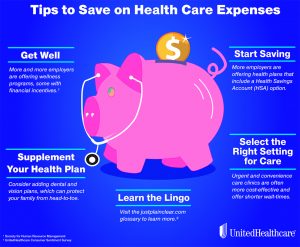 Over the last 10 years, out-of-pocket health care costs for Americans have more than doubled, with medical expenses now accounting for 8 percent of annual household spending, according to the Consumer Expenditure Figures report.
Over the last 10 years, out-of-pocket health care costs for Americans have more than doubled, with medical expenses now accounting for 8 percent of annual household spending, according to the Consumer Expenditure Figures report.
With tax season just behind us, this is an ideal time for you to evaluate your financial wellbeing and take steps to becoming a savvier consumer, especially when it comes to health care. With national health care spending now exceeding $3.2 trillion annually, it is crucial for all Americans/Florida residents to become more thoughtful health care consumers.
Gregory Reidy, CEO, UnitedHealthcare Florida, shares five tips to help you more efficiently navigate the health care system, which could improve your personal and financial fitness.
Learn the Lingo: Do you know the difference between co-payment and co-insurance? Don’t worry, it’s pretty common. In fact, just 7 percent of Americans were able to successfully define all four basic health coverage terms: premium, deductible, copayment and coinsurance, according to the recent UnitedHealthcare Consumer Sentiment Survey. By understanding these terms, people can help maximize the value of their health benefits and help avoid unnecessary or surprise medical bills. There are a number of tools online, including the justplainclear.com glossary, available in English and Spanish, to help people learn or review health insurance terms.
Work on Wellness: An estimated 70 percent of employers already offer wellness programs and eight percent more plan to do so during the next year, with some programs offering financial incentives, according to the Society for Human Resource Management. The value of corporate wellness incentives has increased to $693 per employee per year, up from $430 five years ago, according to a recent study from the National Business Group on Health. However, the study found that fewer than half of eligible employees earned the full incentive, with workers leaving millions of dollars of unclaimed rewards. Some wellness programs now include activity trackers, which help enable some employees to earn up to $1,500 per year in incentives by meeting daily walking goals. Likewise, websites such as achievemint.com enable people to earn cash rewards for walking.
Seek to Save More: More employers are offering health plans that include a Health Savings Account (HSA) option. An HSA is like a personal bank account specifically for health-related expenses – you own all the money in it, including contributions from your employer. HSAs offer a triple tax advantage: money is deposited pre-tax from your paycheck and accrues interest tax-free, and withdrawals are not taxed as long as funds are used for qualified health-related expenses. With a growing number of Americans now enrolled in a consumer-
directed health plan, these types of savings accounts will become increasingly important.
Select the Setting for Care: There are many places for people to seek care, including urgent and convenience care clinics that are often more costeffective and offer shorter wait times than other health care facilities. The growing availability of telemedicine is making routine and preventive care available online and through mobile devices, with the cost of a video-based virtual visit (usually less than $50) offerings savings when compared to costs for similar minor medical needs treated at a doctor’s office (approximately $80), urgent care facility (approximately $160) or emergency room (approximately $650), according to UnitedHealthcare claims data. Recent advances in audio and video technology are enabling people to obtain a diagnosis and necessary prescriptions for minor medical needs including allergies, sinus and bladder infections, bronchitis and other conditions.
Don’t Forget Vision and Dental Coverage: Maintaining your health includes more than just medical coverage. Consider adding dental and vision plans, which can protect you and your family from head to toe. Research suggests a connection between oral health and overall health, so adding a dental plan may help prevent larger medical issues. A vision plan may offer eye exams that can help identify chronic conditions such as diabetes, and offer reduced pricing on frames and lenses. Financial protection products, such as critical illness or hospital indemnity plans, can help provide important safeguards for unexpected health situations.
Following are information and research sources available to the general public that provide additional insights and information on how you can improve and better manage your health care expenses:
Find Care & Cost Estimators: www.uhc.com/findcare
Bureau of Labor Statistics – Consumer Health Expenditures: www.bls.gov/opub/btn
Health Care Glossary & Medical Terms: www.justplainclear.com
Health care tools, resources and benefit programs: www.businessgrouphealth.org
Cash rewards for improving health: www.achievemint.com
Check Also
Recurrent UTIs: Addressing the Risk of Antibiotic Resistance
Urinary tract infections (UTIs) are common bacterial infections that affect millions of individuals worldwide each …
 Central Florida Health and Wellness Magazine Health and Wellness Articles of the Villages
Central Florida Health and Wellness Magazine Health and Wellness Articles of the Villages



